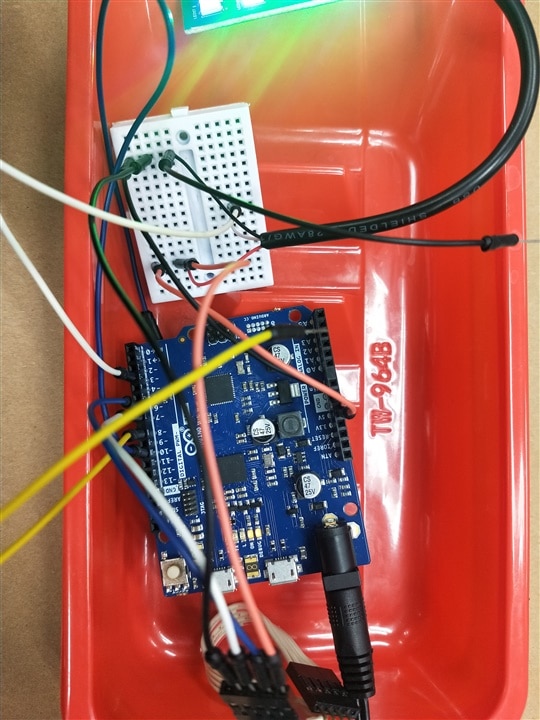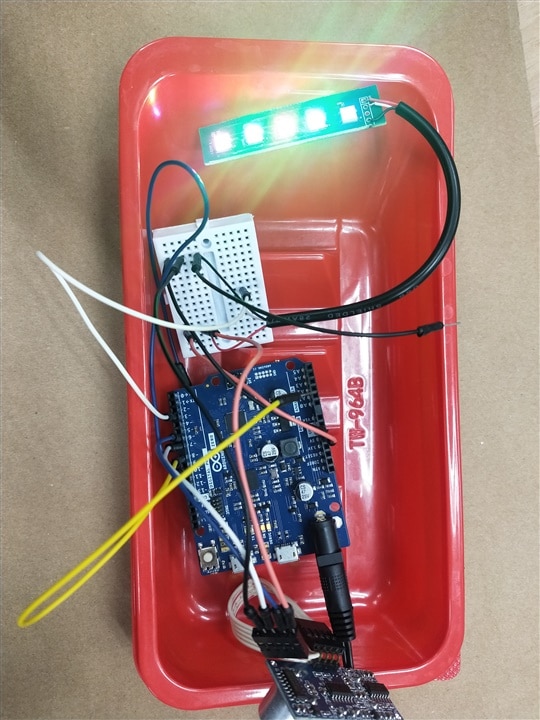1. Project Overview
1.1 Project Background
This project designs and implements an Arduino-based intelligent car ambient lighting control system that integrates multiple lighting scene modes, brightness adjustment, proximity sensing control, and other functions, providing an intelligent and personalized lighting solution for automotive interior spaces.
1.2 System Features
- Multiple Lighting Scenes: 5 switchable lighting effects
- Intelligent Gesture Control: Hand gesture switching via ultrasonic sensor
- Adjustable Brightness: 5-level brightness adjustment for different environments
- Energy Efficient: Automatic on/off and low-power design

2. System Components
2.1 Hardware Components List
| Component | Specification | Quantity | Purpose |
|---|---|---|---|
| Arduino Zero | 1 | Main Controller | |
| WL-ICLED Strips | WL-ICLED LEDs | 3 strips × 5 LEDs | Ambient Light Source |
| WS2816 Single LED | Individual control | 1 | Auxiliary Indicator |
| HC-SR04 Ultrasonic Module | Detection range 2-400cm | 1 | Proximity Detection |
| Buttons | 6×6mm momentary | 2 | Brightness/Power Control |
| Demo Frame- Car Chamber |
2.2 Hardware Connection
3. System Architecture Design
3.1 System Block Diagram
4. Functional Implementation Details
4.1 Lighting Scene Modes
Scene 1: Static Warm White
void scene1Static() {
// Three strips show warm white, single LED shows white
for (int i = 0; i < 5; i++) leds[i] = CRGB::White;
// ... Other LED configurations
}
Scene 2: Breathing Effect
- Blue gradient breathing effect
- Smooth brightness transition (30ms intervals)
Scene 3: Rainbow Flow
- Full color spectrum cycling flow
- 7-color gradient, dynamic changes
Scene 4: Music Rhythm Simulation
- Random color changes simulating music rhythm
- Three different flashing patterns
Scene 5: Color Cycling
- 5 preset colors cycle automatically
- 1-second interval auto-switching
4.2 Proximity Detection Algorithm
void checkProximitySceneChange() {
float distance = afstandssensor.distanceCM();
// Detect gestures in 10-20cm range
if (distance >= 10 && distance <= 20) {
if (proximityHandled) {
changeSceneByProximity(); // Switch scene
proximityHandled = false;
}
} else {
proximityHandled = true;
}
}
4.3 Brightness Control Logic
void adjustBrightness() {
currentBrightness += 51; // 51 = 255/5
if (currentBrightness > 255)
currentBrightness = 25; // Minimum 10% brightness
FastLED.setBrightness(currentBrightness);
}
Smart Car Ambient Lighting Control System Project Report
1. Project Overview
1.1 Project Background
This project designs and implements an Arduino-based intelligent car ambient lighting control system that integrates multiple lighting scene modes, brightness adjustment, proximity sensing control, and other functions, providing an intelligent and personalized lighting solution for automotive interior spaces.
1.2 System Features
- Multiple Lighting Scenes: 5 switchable lighting effects
- Intelligent Gesture Control: Hand gesture switching via ultrasonic sensor
- Adjustable Brightness: 5-level brightness adjustment for different environments
- Energy Efficient: Automatic on/off and low-power design
2. System Components
2.1 Hardware Components List
| Component | Specification | Quantity | Purpose |
|---|---|---|---|
| Arduino Nano/Uno | ATmega328P | 1 | Main Controller |
| WS2816 LED Strips | WL-ICLED LEDs | 3 strips × 5 LEDs | Ambient Light Source |
| WS2816 Single LED | Individual control | 1 | Auxiliary Indicator |
| HC-SR04 Ultrasonic Module | Detection range 2-400cm | 1 | Proximity Detection |
| Tactile Buttons | 6×6mm momentary | 2 | Brightness/Power Control |
| Resistors | 220Ω, 10kΩ | Several | Signal Conditioning |
| Connecting Wires | Dupont wires | Several | Circuit Connections |
| Power Module | 5V/3A DC-DC | 1 | System Power Supply |
3. System Architecture Design
3.1 System Block Diagram
3.2 Software Architecture
4. Functional Implementation Details
4.1 Lighting Scene Modes
Scene 1: Static Warm White
void scene1Static() {
// Three strips show warm white, single LED shows white
for (int i = 0; i < 5; i++) leds[i] = CRGB::White;
// ... Other LED configurations
}
Scene 2: Breathing Effect
- Blue gradient breathing effect
- Smooth brightness transition (30ms intervals)
Scene 3: Rainbow Flow
- Full color spectrum cycling flow
- 7-color gradient, dynamic changes
Scene 4: Music Rhythm Simulation
- Random color changes simulating music rhythm
- Three different flashing patterns
Scene 5: Color Cycling
- 5 preset colors cycle automatically
- 1-second interval auto-switching
4.2 Proximity Detection Algorithm
void checkProximitySceneChange() {
float distance = afstandssensor.distanceCM();
// Detect gestures in 10-20cm range
if (distance >= 10 && distance <= 20) {
if (proximityHandled) {
changeSceneByProximity(); // Switch scene
proximityHandled = false;
}
} else {
proximityHandled = true;
}
}4.3 Brightness Control Logic
5. Actual Effect Demonstration
5.1 Installation Effect Diagram
5.2 Scene Effect Description
| Scene | Visual Effect | Application Scenario |
|---|---|---|
| Scene 1 | Soft warm white static light | Night driving, reduce glare |
| Scene 2 | Blue breathing gradient | Highway cruising, relaxation |
| Scene 3 | Rainbow flowing effect | Entertainment, atmosphere enhancement |
| Scene 4 | Random rhythm flashing | Music appreciation, party mode |
| Scene 5 | Color cycle switching | Personalized customization |
5.3 Control Experience
- Gesture Control: Wave hand 10-20cm from sensor to switch scenes
- Visual Feedback: LED flashing indicates current scene number
- Brightness Memory: System remembers last brightness setting
- Energy Saving: Automatic low-power mode when inactive
6. Project Photos and Final Effects

7. Codes
#include <FastLED.h>
#include <afstandssensor.h>
#define NUM_LEDS 16
#define DATA_PIN 3
#define TRIGGER_PIN 6
#define ECHO_PIN 7
#define BUTTON_BRIGHTNESS_PIN 8
#define BUTTON_POWER_PIN 9
#define MAX_DISTANCE 50
CRGB leds[NUM_LEDS];
AfstandsSensor afstandssensor(TRIGGER_PIN, ECHO_PIN);
bool powerOn = true;
uint8_t currentScene = 0;
uint8_t currentBrightness = 128;
uint8_t maxBrightness = 255;
unsigned long lastDistanceCheck = 0;
unsigned long lastProximityTime = 0;
bool proximityHandled = true;
const unsigned long PROXIMITY_DEBOUNCE = 1000;
const uint8_t NUM_SCENES = 5;
CRGB scene1Colors[3] = { CRGB::White, CRGB::White, CRGB::White };
CRGB scene2BaseColor = CRGB::Blue;
uint8_t scene3Hue = 0;
CRGB scene4Colors[3] = { CRGB::Red, CRGB::Green, CRGB::Blue };
CRGB scene5Colors[5] = { CRGB::Red, CRGB::Orange, CRGB::Yellow, CRGB::Green, CRGB::Blue };
uint8_t scene5Index = 0;
void setup() {
Serial.begin(9600);
FastLED.addLeds<WS2816, DATA_PIN, GRB>(leds, NUM_LEDS);
FastLED.setBrightness(currentBrightness);
pinMode(BUTTON_BRIGHTNESS_PIN, INPUT_PULLUP);
pinMode(BUTTON_POWER_PIN, INPUT_PULLUP);
allOff();
FastLED.show();
}
void loop() {
checkButtons();
checkProximitySceneChange();
if (powerOn) {
switch (currentScene) {
case 0: scene1Static(); break;
case 1: scene2Breathing(); break;
case 2: scene3Rainbow(); break;
case 3: scene4Music(); break;
case 4: scene5ColorCycle(); break;
}
} else {
allOff();
FastLED.show();
delay(100);
}
}
void checkButtons() {
static unsigned long lastDebounceTime = 0;
static bool lastBrightnessState = HIGH;
static bool lastPowerState = HIGH;
bool brightnessState = digitalRead(BUTTON_BRIGHTNESS_PIN);
bool powerState = digitalRead(BUTTON_POWER_PIN);
if (brightnessState == LOW && lastBrightnessState == HIGH && millis() - lastDebounceTime > 200) {
currentBrightness += 51;
if (currentBrightness > 255) currentBrightness = 25;
FastLED.setBrightness(currentBrightness);
Serial.println(currentBrightness);
lastDebounceTime = millis();
}
lastBrightnessState = brightnessState;
if (powerState == LOW && lastPowerState == HIGH && millis() - lastDebounceTime > 200) {
powerOn = !powerOn;
lastDebounceTime = millis();
}
lastPowerState = powerState;
}
void checkProximitySceneChange() {
if (millis() - lastDistanceCheck > 300) {
float distance = afstandssensor.afstandCM();
Serial.print(distance);
Serial.println(" cm");
if (distance >= 10 && distance <= 20) {
if (proximityHandled && millis() - lastProximityTime > PROXIMITY_DEBOUNCE) {
changeSceneByProximity();
proximityHandled = false;
lastProximityTime = millis();
}
} else {
proximityHandled = true;
}
lastDistanceCheck = millis();
}
}
void changeSceneByProximity() {
currentScene = (currentScene + 1) % NUM_SCENES;
Serial.println(currentScene + 1);
proximityFeedback();
}
void proximityFeedback() {
CRGB feedbackColor = getSceneColor(currentScene);
for (int i = 0; i < 2; i++) {
fill_solid(leds, NUM_LEDS, feedbackColor);
FastLED.show();
delay(150);
allOff();
FastLED.show();
delay(100);
}
showSceneNumber(currentScene + 1);
}
void showSceneNumber(uint8_t sceneNum) {
allOff();
for (int i = 0; i < sceneNum && i < 5; i++) {
leds[i] = CRGB::Green;
}
FastLED.show();
delay(800);
allOff();
FastLED.show();
}
CRGB getSceneColor(uint8_t scene) {
switch (scene) {
case 0: return CRGB::White; // 场景1:白色
case 1: return CRGB::Blue; // 场景2:蓝色
case 2: return CRGB::Purple; // 场景3:紫色
case 3: return CRGB::Yellow; // 场景4:黄色
case 4: return CRGB::Cyan; // 场景5:青色
default: return CRGB::White;
}
}
void scene1Static() {
for (int i = 0; i < 5; i++) leds[i] = scene1Colors[0]; // 第一串
for (int i = 5; i < 10; i++) leds[i] = scene1Colors[1]; // 第二串
for (int i = 10; i < 15; i++) leds[i] = scene1Colors[2]; // 第三串
leds[15] = CRGB::White; // 单独的WS2816
FastLED.show();
delay(100);
}
void scene2Breathing() {
static uint8_t breathValue = 0;
static bool breathingUp = true;
CRGB color = scene2BaseColor;
color.fadeToBlackBy(255 - breathValue);
fill_solid(leds, NUM_LEDS, color);
FastLED.show();
if (breathingUp) {
breathValue += 2;
if (breathValue >= 200) breathingUp = false;
} else {
breathValue -= 2;
if (breathValue <= 30) breathingUp = true;
}
delay(30);
}
void scene3Rainbow() {
fill_rainbow(leds, NUM_LEDS, scene3Hue, 7);
FastLED.show();
scene3Hue += 1;
delay(50);
}
void scene4Music() {
static unsigned long lastChange = 0;
static uint8_t pattern = 0;
if (millis() - lastChange > random(100, 300)) {
pattern = random(3);
lastChange = millis();
}
switch (pattern) {
case 0:
fill_solid(leds, 5, scene4Colors[0]);
fill_solid(leds + 5, 5, scene4Colors[1]);
fill_solid(leds + 10, 5, scene4Colors[2]);
break;
case 1:
fill_solid(leds, NUM_LEDS, scene4Colors[random(3)]);
break;
case 2:
fill_gradient_RGB(leds, NUM_LEDS,
scene4Colors[0], scene4Colors[1], scene4Colors[2]);
break;
}
leds[15] = scene4Colors[random(3)];
FastLED.show();
delay(80);
}
void scene5ColorCycle() {
static unsigned long lastChange = 0;
if (millis() - lastChange > 1000) {
CRGB color = scene5Colors[scene5Index];
fill_solid(leds, NUM_LEDS, color);
FastLED.show();
scene5Index = (scene5Index + 1) % 5;
lastChange = millis();
}
}
void allOff() {
fill_solid(leds, NUM_LEDS, CRGB::Black);
}
void setStrip(uint8_t stripNum, CRGB color) {
uint8_t start = stripNum * 5;
uint8_t end = start + 5;
if (stripNum == 3) {
leds[15] = color;
} else {
for (int i = start; i < end && i < NUM_LEDS; i++) {
leds[i] = color;
}
}
}
-

DAB
-
Cancel
-
Vote Up
0
Vote Down
-
-
Sign in to reply
-
More
-
Cancel
Comment-

DAB
-
Cancel
-
Vote Up
0
Vote Down
-
-
Sign in to reply
-
More
-
Cancel
Children